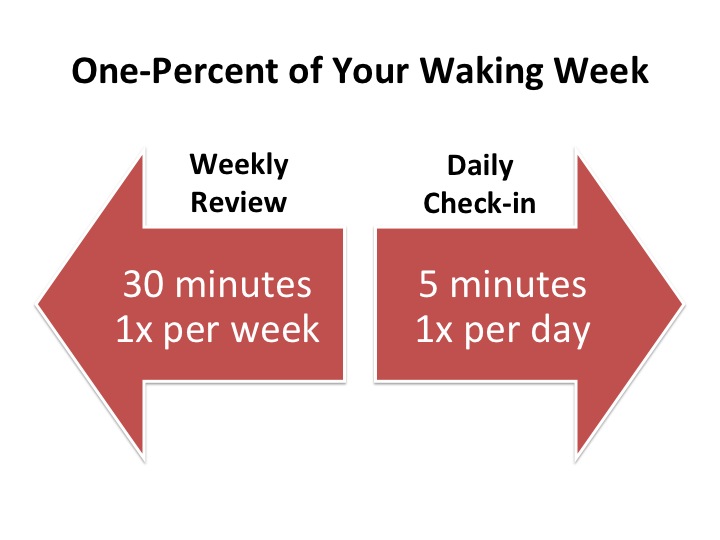One week has 168 hours in it. No more, no less.
Subtract the time you spend sleeping and doing basic chores, like bathing, eating, and getting dressed, and what you have left is about 100 hours.
The cultural narrative we’ve embraced—that there’s never enough time to do the things that matter most in life—doesn’t hold water in light of these 100 waking hours.
It takes 4% of 100 hours to exercise rigorously every other day. It takes 3% of 100 hours to have a big family meal together on the weekend, including cooking and cleaning up. And it takes 2% of 100 hours to read from a book to your children before they go to sleep at night.
When you consider the fact that the average American spends more than 30 hours a week watching television, you realize that the use of our time is more about the choices we’re making than about being too busy.
The secret to using these 100 hours well, instead of wasting them week after week, is simple planning. Like the rudder on a ship, if you take one out of 100 hours—just 1% of your waking week—to plan, you’ll end up charting the course of your life in a very different direction than if you just let the wind and waves drive you.
I refer to this as the hour that changes everything and advise my clients to spent it in two ways. The first 30 minutes is spent one day a week in proactive weekly planning. The next 30 minutes is spent five minutes a day for the remaining six days of the week on daily check-in’s.
Here’s how each work:

The First 30 Minutes: Proactive Weekly Planning
The most important discipline you can instill in your life in this new year is scheduling a weekly planning meeting with yourself and keeping that meeting without fail.
I have a client who does this on Friday morning, another who does it on Sunday evening. I prefer the quiet of Sunday morning while my family is sleeping in. It’s crucial, however, that you carve out a private, uninterrupted space of 30 minutes every week to reflect and plan.
Socrates once said that the unexamined life is not worth living. I would like to modify his words slightly: The unexamined week is not worth living. For our life is made up of the days in our week, and the effectiveness of those days is dependent on their honest examination.
What do you do in that 30 minutes?
1. Answer these four questions
All the activities in your week should flow from the vision you have for your life and work. To ensure that this is the case, start this meeting you’re having with yourself by answering these four questions:
- What kind of person will you be? How are you staying healthy and strong physically, mentally, emotionally, and spiritually?
- What kind of relationships will you have? How are you investing in the lives of those whom you love the most?
- What kind of work will you do? What’s the best use of the gifts, talents, and experiences you possess?
- How will you give back? What contribution will you make to others who are less fortunate than yourself?
Over time, you’ll develop set answers for these questions, and that’s a good thing. Taken together they define what it truly means to have a vision for one’s life and work.
2. Answer this one question
Now ask yourself this one question, “What’s the most important thing I can do this week for these areas of my life?”
Your answer may not be just one thing, it may be two or three things, but they must be the most important things for the upcoming week. Neither are these things everything you’ll do in the week. Again, they’re the most important things. Your first things.
On the list may be regular exercise, a date night with your spouse, visiting your aging parents, one-on-one meetings with your team, follow-up calls to current prospects, or writing thank you notes to new customers.
All tasks are not created equal, and you’re choosing the most important ones for the coming week. You may have a journal where you write these things down or an app where you record them digitally. Do it. Don’t keep this stuff in your head.
Some of the activities that come to mind as I conduct my weekly planning meetings are recurring tasks, like reading and exercise, but many times ideas have come to me in my Sunday morning planning sessions that I had never thought of before and are the perfect solution to a pressing concern. I’ve planned trips with my kids and employee rewards programs, marketing campaigns and consulting innovations.
3. Schedule it
If you had a doctor’s appointment on Friday, how would make sure you got there? You would put it in you calendar, of course. Nothing really magical about that. The fact that a doctor’s appointment is scheduled on Friday allows all the other activities in your day, and even your week, to fit around that appointment.
This is what you do with the activities you’ve identified in your weekly planning meeting. Put them in your calendar giving each a specific day, date, and time.
Here’s why this is so important.
Imagine in front of you a five-gallon bucket, a pile of rocks, and a pile of sand. If you put the sand in the bucket first, there’ll be no room for the rocks. But if you put the rocks in the bucket first, the sand will sift around the rocks.
I refer to this phenomenon as Bill’s Law of Scheduling. Bill’s Law of Scheduling states:
Unscheduled events will conform to scheduled events.
In other words, when you place your top priorities in your schedule–your rocks–everything else will adjust to them. We all know email can take fifteen minutes or an hour and fifteen minutes. The difference? The way you schedule your time. Sand conforms to rocks.
Fundamentally, what you are asking yourself is this, what are your highest personal and professional priorities for the week? Having determined them, schedule them so you live life differently, based on importance and not urgency (or mere sloth watching 30 hours of television).
The Second 30 Minutes: Dynamic Daily Check-In’s
Now, just like you’ve scheduled a 30-minute planning meeting with yourself one day in the week, schedule a 5-minute check-in meeting with yourself the other six days.
The vibe of the daily check-in, however, isn’t the quiet reflection of a weekly planning meeting, but the quick connection of a football huddle. Your goal is to arrange the day in light of the weekly plan you’ve made and the dynamic developments that have transpired during the week.
Missed your workout because of an unplanned sales meeting? Reschedule it for this afternoon. Skipped date night because of sick kids? Reschedule it for the weekend when your sister’s available to watch them.
I have clients who prefer to do this at the end of the day and others who do it at the beginning. But do it without fail.
A daily check-in allows you to stay true to your highest priorities while responding to the challenges each new day brings. In this way your plans are not a straightjacket that binds you, but an agenda that you hold with an open hand: getting to all of the items on that agenda, but, perhaps, in a different order than you originally outlined.
Any cross-country flight, and any week in the ever-changing world in which we live and work, has things happen that take it off course. Regular mid-course corrections keep your week on track and get it to your desired destination.
Genius of AND
There I sat with my 13-year-old daughter on a dirt floor eating rice and beans with some of the poorest people on the planet.
We traveled over 40 hours in a cramped van to the southern half of Baja Mexico to provide humanitarian aid to migrant farm workers laboring there. A trip that would have never happened except for the hour that changes everything.
I’ve raised three active children. As a dad it was critically important to me that they see how the rest of the world really lives. So my wife and I made sure they traveled internationally as many times as we could afford.
But here was my baby, my third-born daughter, living as an only child in an empty house as the other two moved-on to college. I wanted to take some extra time just to be with her. How could I do that?
I asked myself that question during one of my weekly planning meetings. A mere few minutes later, when we went to church as a family, the opportunity to go on a mission trip to serve migrant farmer workers was announced, and we signed up immediately.
For a solo consultant, however, taking two weeks out of the country on a mission trip is not an easy thing to do.
First, there’s the work that would be lost just before the summer slowdown, then there’s the complete disconnection from the outside world, and finally there’s the work that would have to be squeezed in both before and after the trip.
Enter Bill’s Law of Scheduling.
As my clients heard what I was doing with my daughter, their response was amazing. Each of them applauded my efforts and bent over backwards to accommodate my schedule. One person actually offered to financially support the trip!
Eating rice and beans on a dirt floor in Mexico would never be considered an elegant dining experience. But it’s the meal my daughter remembers more than any other meal we’ve had together almost a decade later.
Due to the 100 waking hours we’re given every week, we don’t need to make either/or choices between professional success and personal satisfaction. We can have both. Jim Collins refers to this as the “Genius of the AND” in his classic book Built to Last,
“Instead of being oppressed by the ‘Tyranny of the OR,’ highly visionary companies liberate themselves with the ‘Genius of the AND’–the ability to embrace both extremes of a number of dimensions at the same time. Instead of choosing between A or B, they figure out a way to have both A and B.”
The same could be said about a life that’s built to last.
Just ask my daughter.


